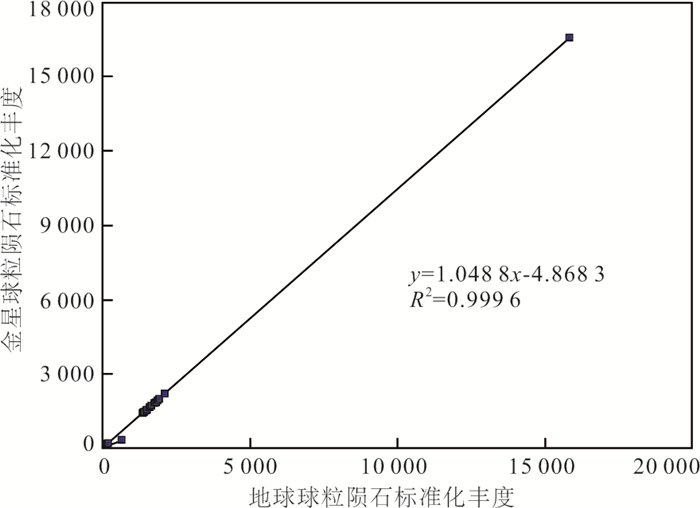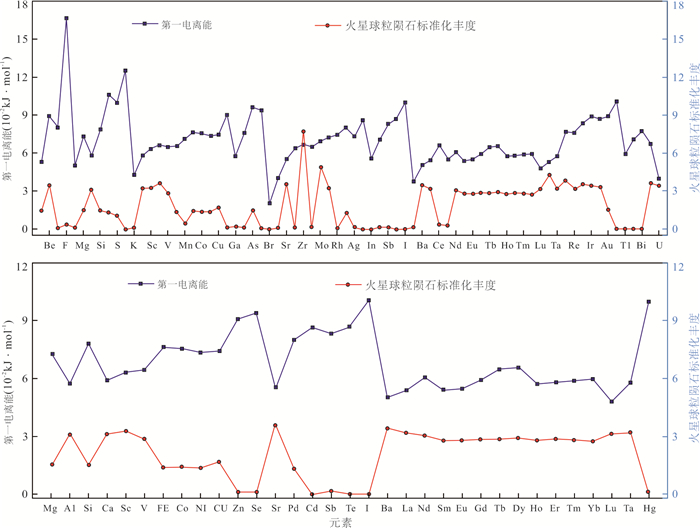Distribution of Elements in Different Natural Systems: A General Rule after the Even Number Law, an Example of Terrestrial Planets
-
摘要: 在地球化学、天体化学乃至宇宙化学领域中,有一个应用十分广泛的著名的偶数规则(即Oddo-Harkins规律),该规律认为,元素在太阳系分布中,原子序数为偶数的元素丰度通常会比相邻的两个奇数元素丰度值高.通过研究发现,化学元素在宇宙不同自然体系中分布与分配,至少对非亲气元素而言,在统计上还呈周期性变化,而这种周期性变化恰好和元素周期律吻合.而偶数规则也和元素周期性变化规律存在着某种深刻的联系,实际上是同一地球化学现象不同侧面的反映.以地球和金星等自然体系的化学元素质量丰度的比值为例,说明任意两个自然体系,其形成与演化的历程、机制、程度、条件以及物质的来源和化学构成愈是接近,二者之间的元素比值的变化波形就愈符合元素周期律.定量地确定元素在自然体系中分布/分配曲线对元素周期性变化曲线的吻合程度.元素在自然体系分布上的元素周期性变化规律的发现及其量化描述的实现,为更科学地、精确地计算、校验和获取自然体系中化学元素的一些基础数据,提供了一个全新的思路.
-
关键词:
- 自然体系 /
- 化学元素的分布与分配 /
- 元素分布的周期性变化 /
- 周期律 /
- 地球化学
Abstract: The even number law (that is,"Oddo-Harkins" law) holds that a given element with even atomic number is more abundant than both the adjacent elements with odd atomic numbers,which is widely-used in geochemistry,astrochemistry and even cosmochemistry. The present study shows that the distribution/allocation of chemical elements (at least for non-atmophile elements) in various natural systems also exhibits cyclical changes in statistics,which is well consistent with the "Periodic Law". In fact,there exists certain intrinsic relationship between the even number law and the cyclical changes stated in present study,and they just signature a same geochemical phenomenon from different angles. For two random natural systems (the Earth and Venus,for instance),the more similar the processes,mechanisms,stages and conditions of their formation and evolution,their material sources and chemical compositions are,the more consistent their variation waveforms of elemental abundance ratios are with the "Periodic Law". The matching degree between the distribution/allocation curve of elements in various natural systems and the periodic variation curve of these elements has been further determined. Overall,the discovery of cyclical changes of elemental distribution and its quantitative characterization provide a new perspective for calculating,checking and acquiring basic data on chemical elements in a natural system. -
0. 引言
对于自然体系或不同地质体,如太阳系或地球、金星、月球等其他几种类地行星、卫星的元素丰度以及某些行星内部不同结构圈层的化学元素之丰度,许多科学家用不同的研究、计算方法,取得了大量的数据. 例如,Ross and Aller(1976) 根据太阳大气的光谱资料发表了太阳大气92个元素的丰度数据;Goldschmidt编制了第一个宇宙元素丰度表(陈骏和王鹤年,2004);Anders and Ebihara(1982) 公布了宇宙元素丰度表;Palme et al.(1981)发表了初始太阳星云的元素丰度值;Morgan and Anders(1980)根据Ganapathy和Anders模式,计算出水星、金星、地球和火星的元素丰度值;涂光帜(1984)、欧阳自远(1988)曾将元素的天体化学性质分为亲铁、亲石等五组类型;黎彤(1976)给出了地球92个元素丰度数据;Brownlow(1979)发表了球粒陨石92个元素的丰度值(个别元素数据空缺);Anders and Grevesse(1989)又给出了CI型球粒陨石平均数据;Sun and Mcdonough(1989) 给出了球粒陨石35个元素丰度值. 最近几年,美国宇航局的专家们还探讨了火星地壳的演化等重大科学问题(Sautter et al., 2015),并发现了火星存在着水合盐的光谱证据(Ojhal et al., 2015). 即便在同一自然体系,例如地球的不同圈层——地核、原始地幔、亏损地幔、富集地幔以及上、中、下地壳的元素丰度的推算,前人也采用了不同的研究、计算方法,获得了大量的数据(Ringwood,1975;Henderson,1982;Anderson,1983;Taylor and McLennan, 1985;Sun and Mcdonough, 1989;黎彤和倪守斌,1990;Krauskopf and Bird, 1995;Wedepohl,1995;Gao et al., 1998a, 1998b;Rudnick and Gao, 2003;Hu and Gao, 2008;Gaschnig et al., 2016). 这一切都为深入研究不同自然体系的地球化学基本问题以及地球化学在矿产资源的开发应用,奠定了基础.
本文的主旨,是在前人研究基础上,探讨化学元素在宇宙不同自然体系分布的一个既古老而又十分崭新的规律. 限于目前一些数据获取方面的条件,本次研究所涉及的化学元素,通常不包括类地行星的亲气性元素.
1. 数据和方法
本次研究的自然体系中的一些常见元素丰度数据,如月海玄武岩的化学元素的丰度等,全部来自于相关经典文献和最新出版教材. 对这些有益的数据的具体研究方法和思路是:先将这些数据采取球粒陨石归一化方法或其他方法(如,求出所研究的某两个自然体系的化学元素比值的方法),以期获得可表征其某种地球化学行为的参量,继而用数学和计算机方法定量求出这些元素参量的变化趋势与其一一对应的元素的某个内部结构参数变化趋势的相似度,进行深度考察与讨论,为最后所得出的相关科学结论提供依据.
需要说明的是,本次研究所采用的有些数据虽然发表很早,但仍不失其科学研究价值. 首先是因为,迄今为止,有些天体,如Morgan and Anders(1980)发表的火星、水星、金星的元素丰度数据,尚未见有新发表的数据可以替代;二是因为,不同学者对天体的元素丰度的研究方法虽然不同,但只要方法得当,最后得到的数据结果都大同小异,与数据发表时间的早晚没有太大的关系(张德会和赵伦山,2013). 如,有关地壳的元素丰度组成,一些国内外报道的研究结果就没有根本性的差别. 因此作为一个统计结果而言,本次研究所采用的数据无论是早是晚,都不会影响到本次研究所获得的结论. 此外,本文虽涉及到某些天体化学问题,但本质上,还是一篇以探讨地球化学基本问题为宗旨的论文,故本次研究所使用的元素丰度,除非特别说明(如本文的图 3),均指化学元素的质量丰度.
 图 3 化学元素宇宙丰度球粒陨石标准化后的变化趋势和元素第一电离能变化趋势的对比元素的第一电离能数据据李贵全(2001);宇宙元素丰度的数据据Anders and Ebihara(1982);球粒陨石数据据Brownlow(1979); H、He、C、N、O等亲气元素数据空缺,二者均以106Si原子数为标准Fig. 3. Comparison of variation trend between the chondrite⁃normalized abundances of elements in the universe and their first ionization energies
图 3 化学元素宇宙丰度球粒陨石标准化后的变化趋势和元素第一电离能变化趋势的对比元素的第一电离能数据据李贵全(2001);宇宙元素丰度的数据据Anders and Ebihara(1982);球粒陨石数据据Brownlow(1979); H、He、C、N、O等亲气元素数据空缺,二者均以106Si原子数为标准Fig. 3. Comparison of variation trend between the chondrite⁃normalized abundances of elements in the universe and their first ionization energies2. 结果与讨论
2.1 化学元素在太阳系的分布:元素分布的周期性变化规律
目前,对化学元素在太阳系乃至宇宙中的分布特点,人们已有的共识是:元素分布非常不均匀,其丰度差别甚至可达到10个数量级以上,但仍旧有规律可循. 因为,无论是太阳系还是其中的某个成员——例如地球,其分布都符合偶数规则(即Oddo-Harkins规律),即原子序数为偶数的元素丰度比相邻的两个奇数元素的丰度值高;四倍规则,即元素原子量可被4整除的元素,其丰度值高(中国科学院地球化学研究所,2000);丰度递减规律,即随着原子序数增加,原子序数小于50的元素丰度呈指数迅速递减,而原子序数大于50的元素不仅丰度低,且丰度值几乎不变,重核元素丰度低等等. 这是因为,按照元素的热核成因说,原子内部的质子数和中子数相等或者二者之和(质量数)呈现出偶数关系,元素的原子核才最为稳定,因而这类元素丰度才可能趋于最大(张德会和赵伦山,2013).
假如宇宙或太阳系的物质(化学元素)总量是恒定的话,化学元素在宇宙或太阳系中不同的自然体系以及其子体系中的分布,可以看成是自然演化过程中,元素在各个体系(或子体系)中的重新分配所致,那么,在这个分配或分布过程中,除了存在着前人所指出的偶数规则、四倍规则、递减规律外,还有其他规律吗?
先看这样一个例子. 图 1是两块月海玄武岩分析所得的29个元素丰度比值的变化趋势与其相应的元素电负性变化趋势对比结果.
 图 1 月海玄武岩的两块样品A⁃11与A⁃12的29个元素的比值变化趋势与元素的电负性变化趋势对比元素电负性数据据李贵全(2001);月海玄武岩数据据陈骏和王鹤年(2004)Fig. 1. Comparison of variation trend between the abundance ratios of 29 elements from two samples in mare lunar basalt (A⁃11 and A⁃12) and their electro⁃negativities
图 1 月海玄武岩的两块样品A⁃11与A⁃12的29个元素的比值变化趋势与元素的电负性变化趋势对比元素电负性数据据李贵全(2001);月海玄武岩数据据陈骏和王鹤年(2004)Fig. 1. Comparison of variation trend between the abundance ratios of 29 elements from two samples in mare lunar basalt (A⁃11 and A⁃12) and their electro⁃negativities再看图 2中地球和金星的35个元素的比值与其常见的氧化态离子半径变化趋势的对比.
 图 2 地球上Li等35个元素与金星相应的35个元素丰度比值的变化趋势和其常见的氧化态离子半径变化趋势对比元素常见的氧化态离子半径数据据李贵全(2001);地球与金星数据据Morgan and Anders(1980);这里只随意地选用了Sun and Mcdonough(1989)报道的球粒陨石的35个元素Fig. 2. Comparison of variation trend between the abundance ratios of 35 elements in the Earth and Venus, and their common oxidized ionic radii
图 2 地球上Li等35个元素与金星相应的35个元素丰度比值的变化趋势和其常见的氧化态离子半径变化趋势对比元素常见的氧化态离子半径数据据李贵全(2001);地球与金星数据据Morgan and Anders(1980);这里只随意地选用了Sun and Mcdonough(1989)报道的球粒陨石的35个元素Fig. 2. Comparison of variation trend between the abundance ratios of 35 elements in the Earth and Venus, and their common oxidized ionic radii最后,再根据图 3看看宇宙元素丰度用球粒陨石标准化后和元素的第一电离能变化趋势的对比.
上述3个图件中横坐标的元素,均按元素的原子序数从小到大依次排列. 图中月海玄武岩、地球、金星及宇宙和球粒陨石的元素丰度,可见附件1.
从图 1、图 2和图 3中均可发现,任意两个不同自然体系(或地质体)中的化学元素的丰度比值变化波形趋势是可以和元素的电负性、常见离子半径以及第一电离能的变化波形趋势进行对比的. 尽管有的波形方向相反(图 1和图 2),有的波形方向相同(如图 3),但变化趋势却是基本一致的. (从目前的研究程度上看,元素比值的波形与元素某个结构参数变化波形相反还是相同似乎没有什么不同的地球化学意义,例如图 2,如果不是地球/金星的元素比值,而是金星/地球的元素比值,则和离子半径的比值的变化波形就相同了,所以两条折线的对比,重要的不是波形相同还是相反,而是其横轴方向上的变化趋势是否能基本一致)
以上仅是按照地质体或自然体系尺度小、中、大的顺序随意举出的3个例子. 有关这方面的例证举不胜举,读者尽可根据自己的研究工作,任意选用两个不同地质体的微量元素丰度比值,按照上面的研究方法,对作者的上述论点进行验证.
众所周知,元素的几个重要的原子结构参数,如第一电离能、原子半径、离子半径、电负性等,随原子序数增加而呈周期性变化,是元素周期律存在的一个重要内在根据(车云霞和申泮文,1999). 上述实例其实已经说明,在太阳系乃至宇宙中,在自然界里,尽管在不同地质体或自然体系中元素的丰度可以有很大的差异,但元素在不同的地质体或自然体系的分布/分配过程中,在统计上,是服从元素周期律的. 这在宇宙自然界中,尤其是在地球化学领域里,也应该是一个普遍的规律. 当然,也是一个既古老而又十分崭新的规律.
说古老,是因为元素周期律早在19世纪后半叶就已为人们广泛了解;说崭新,是因为化学元素在宇宙不同自然体系的分布中,在统计上居然也符合元素周期律这一事实,之前似乎还未见于报道,并且还在本次研究中赋予了新的科学内涵. 尽管Harkins(1917)也认为元素丰度与原子核的结构均呈明显的周期性,但他说的“周期性”是指偶数元素和奇数元素一起排列时,会出现偶数元素不断地重复出现,因此丰度值不断重复变高的现象,反映了原子核稳定性对元素丰度的控制作用,和本文强调的元素周期律的周期性对元素在不同自然体系分布的控制作用不是一个概念. 在当时的科研条件下,他未能将化学元素在自然体系的分布分配方式和元素周期性变化规律联系起来.
作者在此前,在其他研究领域,如煤地球化学中,也曾发现了煤中微量元素地球化学行为统计上的周期律(杨建业, 2010, 2013;Yang,2011;杨建业等, 2014, 2018, 2020;Yang et al., 2016),但在宇宙天体这样的大尺度范围内也发现了这个统计规律,尚属首次.
读者可能注意到,不同自然体系两两之间对应的化学元素比值的变化趋势与元素周期律的变化波形的吻合程度,常常差别很大. 也一定注意到,图 2中的地球元素丰度和金星元素丰度的比值与其常见的氧化态离子半径大小的变化趋势吻合程度相当高. 这不是偶然的. 如果将收集到的地球和金星74种元素分别用Anders发表的CI型球粒陨石平均值(Anders and Grevesse, 1989)标准化,发现二者之间呈高度正相关. 拟合优度达到0.999 60,相关系数达到0.999 42,如图 4所示. 这可能暗示,两个星球形成演化的机制、历程、程度、条件以及物质的来源、化学成分的构成和元素的活动方式均十分接近,并经过漫长演化时间后达到了某种热力学平衡,才有可能出现这种情形. 当然,图 4中排除了一些重要的亲气性元素,如H、He、C、N、O和一些稀有气体元素等. 因此,这个推测可能针对非亲气性元素或称之为难熔元素而言,比较可靠.
 图 4 地球化学元素/球粒陨石平均-金星化学元素/球粒陨石平均值关系金星与地球的74个元素丰度值据Morgan and Anders(1980);74个元素的CI型球粒陨石平均值据Anders and Grevesse(1989)Fig. 4. Relationship of the abundances of 74 elements in the Earth and Venus normalized by CI⁃type chondrite average values, respectively
图 4 地球化学元素/球粒陨石平均-金星化学元素/球粒陨石平均值关系金星与地球的74个元素丰度值据Morgan and Anders(1980);74个元素的CI型球粒陨石平均值据Anders and Grevesse(1989)Fig. 4. Relationship of the abundances of 74 elements in the Earth and Venus normalized by CI⁃type chondrite average values, respectively事实上,金星和地球确有很大的可比性. 除了因为靠近太阳比较近,地表温度过高(达480 ℃)而不存在水圈且含水硅酸盐较少外,金星在类地行星中,在很多方面似乎比火星更“神似”于地球. 例如,都可能具有铁-镍为主的核,核半径大小也比较接近;都可以将各种气体俘获于其外围,组成成分复杂和密度较大的大气层;都具有极其复杂的地质演化历史——早期剧烈的构造岩浆活动与火山喷发,且至今仍具有明显的构造岩浆活动;后期内力与外力作用形成的地形显著,使古老的火山地形与撞击地形残存较少. 其他一些参数,如恒星周期、距离太阳的平均距离、平均直径、半径、体积、质量、密度,金星也与地球接近. 对地球和金星这种极大的可比性,前人对此早有察觉,并多有报道(中国科学院地球化学研究所,2000;张德会和赵伦山,2013). 此外,据2016年8月10日的《科学美国人》月刊网站报道,有研究者使用三维气候模型研究了早期金星后也认为,数十亿年前,金星可能更像是地球的孪生兄弟. 构成它们的主体材料可能相同. 而且,那时的太阳光照比现在略弱,或许使金星表面相对凉爽,液态水可以聚集成适宜生命存活的大海. 本文的图 2和图 4,实际上是从元素地球化学的角度,再次证实了前人的这些推论.
2.2 不同自然体系元素分配中偏离元素周期律的内部因素初探
这里存在两个问题:(1)既然不同自然体系的元素丰度比值变化波形和元素的一些结构参数,如第一电离能、电负性和离子半径的变化波形都相当吻合,那么,究竟选用哪一个元素结构参数更为合适?(2)任意两个自然体系元素丰度比值的变化波形尽管与元素的某一结构参数的波形变化十分相近,但也会出现若干程度不同的偏差. 原因何在?
第一个问题,和元素不同结构参数变化波形对比之差别的科学意义还在探索之中. 但就任意两个自然体系的元素比值的周期性变化规律而言,如果用元素的离子半径作参照,就可能为同一元素因变价而出现不同的离子半径这一现象所困扰. 因此,笔者倾向于选用元素的第一电离能作为元素的对比结构参数.
至于第二个问题,元素在自然体系分布中的元素周期律既然是一种统计规律,就必然要受多种因素影响而出现一定程度的偏差. 引起偏差的既有外部因素,也有内部因素. 非常复杂,目前还难以说清. 但按照一般的科学常识,可以认为,外部因素有:不同自然体系不同的起源与演化历程,不同的演化条件和不同的物质来源与构成;自然体系形成过程中来自体系外的种种因素的干扰,如系外物质的污染与混合以及不同自然体系所处的地球化学环境等等,都会造成元素在不同的自然体系分配过程中出现程度不同的偏离元素周期律的现象. 此外,限于测试条件,还存在着一个自然体系(特别是某个天体)元素丰度估算误差的问题;而内部因素,则应该与元素本身原子核的稳定性有一定的关系. 后者正是本文下面要探讨的问题.
如果把自然体系中的化学元素丰度经球粒陨石标准化后,所出现的一些偏离元素周期律的现象看成是体系中元素丰度的一种异常现象,那就需要精确地知道,究竟是哪些元素丰度导致了这种“异常”,而这些元素丰度的“异常”又对整个体系的化学元素对元素周期律的吻合程度或偏离程度造成了多大的影响?这就需要有一个很好的定量评估方法. 这个方法已可以用数学方式实现(杨建业等, 2018, 2020).
依照数学上的“遍历算法”,运用MATLAB2014a软件编制的程序不断自动地依次筛选出对元素比值和第一电离能相关性影响较大微量元素,直至剩余元素的比值与其相应的第一电离能的相关系数都在置信水平为0.01时达到0.95为止,就可解决上述问题. 图 5是球粒陨石标准化后的火星化学元素与第一电离能变化态势的对比(图 5a)以及用此种方法筛除掉一些丰度“异常”的元素后与第一电离能变化态势的对比(图 5b).
 图 5 (a) 火星74个元素被球粒陨石平均值标准化后与元素第一电离能变化态势对比;(b)筛除掉一些丰度“异常”的元素后剩余的33个元素球粒陨石标准化后与其第一电离能变化态势对比火星元素丰度据Morgan and Anders(1980);CI型球粒陨石平均值据Anders and Grevesse(1989)Fig. 5. Comparison of variation trend between the chondrite⁃normalized abundances of (a) 74 elements and (b) 33 elements left after sieving those elements with "abnormal" abundances in Mars and their first ionization energies
图 5 (a) 火星74个元素被球粒陨石平均值标准化后与元素第一电离能变化态势对比;(b)筛除掉一些丰度“异常”的元素后剩余的33个元素球粒陨石标准化后与其第一电离能变化态势对比火星元素丰度据Morgan and Anders(1980);CI型球粒陨石平均值据Anders and Grevesse(1989)Fig. 5. Comparison of variation trend between the chondrite⁃normalized abundances of (a) 74 elements and (b) 33 elements left after sieving those elements with "abnormal" abundances in Mars and their first ionization energies对水星、金星、地球、火星4个行星的元素丰度分别用CI型球粒陨石平均值标准化后,用上述方法就可依次求出它们对元素周期律的相似度即吻合程度分别为40.5%、37.84%、33.78%、44.59%. 表 1为4个类地行星筛选后被认为其元素丰度球粒陨石标准化数值之变化波形与元素周期律吻合较好的元素(无以名之,暂时称之为“筛除后剩余的元素”). 表 2则为4个行星被筛除掉的那些丰度值“异常”因而造成整个体系偏离了元素周期律的元素(暂时称之为“被筛除的元素”).
表 1 水星等四大行星球用数学遍历法筛选后符合元素周期律的元素(保留下来的元素)Table Supplementary Table The elements of four planets fitting the Periodic Law well (preserved elements) and their percentages (%)保留下来的元素 even and 4q type element 4q+3 4q+2 4q+1 even⁃even odd⁃even even⁃odd odd⁃odd 水星 Mg, Al, Si, S, Ca, Sc, V, Zn, Se, Cd, I, Te, Ba, La, Pr, Nd, Sm, Eu, Gd, Tb, Dy, Ho, Er, Tm, Yb, Hf, Ta, Pt, Hg, Th 66.66 16.66 16.66 36.66 33.33 26.67 3.33 金星 Al, S, Ca, Sc, V, Cr, Zn, Se, Sr, Cd, Sb, Te, I, Ba, La, Pr, Nd, Sm, Eu, Gd, Tb, Dy, Ho, Er, Tm, Yb, Ta, Hg 60.71 17.86 3.50 17.86 39.28 35.71 17.86 7.14 地球 Al, Ca, Sc, V, Cr, Zn, Se, Sr, Te, I, Ba, La, Pr, Nd, Sm, Eu, Gd, Tb, Dy, Ho, Er, Tm, Yb, Ta, Hg 60 20 20 36 40 20 4 火星 Mg, Al, Si, Ca, Sc, V, Fe, Co, Ni, Cu, Zn, Se, Sr, Pd, Cd, Sb, Te, I, Ba, La, Nd, Sm, Eu, Gd, Tb, Dy, Ho, Er, Tm, Yb, Lu, Ta, Hg 60.6 24.24 3.03 12.12 39.39 33.33 18.18 9.00 表 2 水星等四大行星用数学遍历法筛选后偏离元素周期律的元素(被剔除的元素)Table Supplementary Table The elements of four planets deviating from the Periodic Law (sieved elements) and their percentages (%)被剔除的元素 odd element 4q 4q+3 4q+2 4q+1 even⁃even odd⁃even even⁃odd odd⁃odd 水星 Li, Be, B, F, Na, P, Cl, K, Ti, Cr, Mn, Fe, Co, Ni, Cu, Ga, Ge, As, Br, Rb, Sr, Y, Zr, Nb, Mo, Ru, Rh, Pd, Ag, In, Sn, Sb, Cs, Ce, Lu, W, Re, Os, Ir, Au, Tl, Pb, Bi, U 61.36 22.73 45.45 11.36 20.45 22.73 40.91 15.91 20.45 金星 Li, Be, B, F, Na, Mg, Si, P, Cl, K, Ti, Mn, Fe, Co, Ni, Cu, Ga, Ge, As, Br, Rb, Y, Zr, Nb, Mo, Ru, Rh, Pd, Ag, In, Sn, Cs, Ce, Lu, Hf, W, Re, Os, Ir, Pt, Au, Tl, Pb, Bi, Th, U 56.52 16.67 43.48 13.04 19.57 26.86 39.13 17.39 17.39 地球 Li, Be, B, F, Na, Mg, Si, P, S, Cl, K, Ti, Mn, Fe, Co, Ni, Cu, Ga, Ge, As, Br, Rb, Y, Zr, Nb, Mo, Ru, Rh, Pd, Ag, Cd, In, Sn, sb, Cs, Ce, Lu, Hf, W, Re, Os, Ir, Pt, Au, Tl, Pb, Bi, Th, U 55.10 26.53 40.82 14.29 18.37 28.57 36.73 16.33 18.37 火星 Li, Be, B, F, Na, Mg, P, S, Cl, K, Ti, Mn, Ga, Ge, As, Br, Rb, Y, Zr, Nb, Mo, Ru, Rh, Ag, In, Sn, Cs, Ce, Pr, Hf, W, Re, Os, Ir, Pt, Au, Tl, Pb, Bi, Th, U 58.53 24.39 39.02 12.15 24.39 24.39 41.46 17.01 14.63 从表 1里的数据可以看出,不论是哪个行星,符合元素周期性变化程度较高的大都是符合偶数规则和4q规则以及元素核电荷和中子数组合为偶偶型的元素,其次是符合4q+3规则的元素和奇偶型元素,它们都属于原子核稳定或相对稳定的元素,故其元素丰度也相对稳定,因而在不同自然体系分配中对元素周期律不偏离或偏离程度很小. 4q+2型由于原子核稳定程度差,易受外部环境干扰而元素丰度变化较大,因而和元素偏离周期律的程度呈正相关. 由于丰度低,稳定性差,筛除后剩余的下来的奇奇型元素占比也非常低. 从表 1中还可看出,由水星到火星,被保留的原子序数≥50的元素总是占多数,且分别占2/3、9/14、17/25和18/33,除火星突然变小外,被保留的原子序数≥50元素有随着距离太阳愈远,占比愈大的变化趋势(其原因尚不清楚,有待于天文学家和天体化学家详细解读). 说明元素本身丰度的大小对其周期性分布有一定的影响,从本次研究看,丰度小且变化比较稳定的“微量元素”似乎对元素周期性分布的吻合程度更好. 此外,无论哪个行星,经上述数学方法处理后的“筛除后剩余的元素”中,镧系元素都占相当大的比例,说明镧系元素也属于原子核比较稳定的元素.
而表 2列出的被筛出的元素,却大都是那些不稳定的奇数元素,因此其中的奇数元素数量与周期律相似度几乎呈正相关. 4q+1型元素甚至和四个行星的元素周期律相似度呈良好的正相关,亦即,被筛除的不稳定的4q+1型元素愈多,剩余的元素对周期律的符合程度就愈高. 被筛除的奇偶型元素和奇奇型元素占比也相当高. 特别是奇奇型元素,和表 1相比,占比大幅度提高. 可见元素在不同自然体系分配的元素周期性规律和前人所发现的偶数规则、4倍规则存在着某种有机内在联系. 换言之,偶数规则、4倍规则也好,元素周期律也罢,其实都是同一事物不同侧面的反映. 从表 2还可看出,从水星到火星,被筛除的原子序数≤50的元素均为主要成分,并分别占15/22、15/23、32/49和25/41,总体上有比例减小的趋势. 这暗示着丰度递减剧烈的元素直接影响着元素周期性分布的地球化学性质,只不过这种影响有随着与太阳距离的增大而减小的趋势.
另外,从上面的数据还可以看出,随着行星环境的变化,各种类型的元素占比都发生了一定程度的变化. 总的趋势是,随着与太阳距离的增加,表征行星元素丰度稳定性的偶数规则作用有所降低. 这在水星、金星和地球3个行星中尤其明显. 这可能与行星自然环境有关. 愈是靠近太阳的行星,环境愈是“严酷”(什么样的“严酷”,尚不得知),对元素的原子序数的奇偶性更为敏感,故而愈是靠近太阳的行星,被保留下来的符合元素周期性分布同时又符合偶数规则的元素就愈多. 这个猜想,已在最近发表的一些专著或教材中得到证实. 张德会等认为(张德会和赵伦山,2013),类地行星的物质组成一方面和太阳系其他部分具有统一性,如元素的分布大都符合偶数规则;另一方面,由于类地行星——例如地球,在形成过程中元素会发生地球化学分异,因此还受其形成过程中的元素地球化学性质控制,不仅不完全符合偶数规则,甚至还会出现反偶数规则的现象. 故表 1四大行星中还有少部分被保留下来的元素并不符合偶数规则. 对类地行星这些性质还可进行粗略地定量估计,例如,其统计分布上严格符合周期律变化趋势的这些元素,根据表 1,可估计出其原子内部结构因素约占60.00%~66.66%,这是因为,筛除后剩余的元素中,符合偶数规则和4q规则以及元素核电荷和中子数组合为偶偶型的元素等,占比是60.00%~66.66%;环境因素则占33.34%~40.00%,这是因为,筛除后剩余的元素中,奇型元素占比为33.34%~40.00%. 这就是说,对于化学元素可任意量化的地球化学行为,在统计上,都符合元素周期性变化规律,其中既有原子核稳定性的贡献,也有核外电子不同排布类型的贡献. 但从二者贡献占比来看,总的来说,原子核稳定性的贡献要更大些. 这一结果与前人从元素热核反应起源假说中所推论出的“元素的太阳系丰度主要与它们原子核的性质而非化学性质有关”的结论总体吻合(张德会和赵伦山,2013). 本次研究所发现的“元素在不同自然体系分布周期性变化规律”,既然也是元素的宏观化学行为受控于其内部微观原子结构控制的一种反映,那么,它与偶数规则等有着这样那样的有机联系也就是理所当然的了.
最后,需要指出的是,早期的地球化学曾有一个基本理论法则,即认为“元素原子核的组成决定元素在宇宙中的丰度,原子的外电子层结构制衡元素的地球化学行为”. 这条法则至今仍被奉为经典(张德会和赵伦山,2013). 但是如果承认,大凡元素一切可量化的地球化学行为都基本符合元素周期性变化规律也是一个地球化学的基本理论法则的话,那么本次研究的结果则表明,在类地行星的环境下,制衡元素地球化学行为的不仅是原子的外电子层结构,其中原子核的组成也起相当重要的作用. 诚如上文所言,这二者对于元素地球化学行为的影响占比,还可以进行统计学上的定量求出.这一认识,也与张德会和赵伦山(2013)等人的观点一致.
3. 结语
任意两个自然体系化学元素的丰度尽管差别很大,但二者元素的比值变化趋势,在统计上却符合元素周期律. 至少对非亲气元素而言,是适用这条规律的.
既然元素在不同自然体系中的,周期性分布只是一种统计规律,因此不同自然体系元素的相对分异程度,对元素周期律的符合程度(或偏离程度)必然会出现一定的差别. 同一自然体系化学元素球粒陨石标准化后,相对于元素周期律的变化波形,也会出现一定的偏差. 引起这种差别和偏差的原因很多,有外部因素,也有内部因素. 从本次对类地行星的研究看,可定量地求出,元素外部的环境等因素约占33.34%~40.00%;笔者认为,两个自然体系的形成演化的机制、历程、程度、条件以及其物质来源、化学构成愈是接近,二者元素比值的变化态势对元素周期律的符合程度就愈高. 例如金星和地球.
出现偏差的内部因素则与原子核的稳定程度有很重要的关系. 从本次对类地行星的研究看,亦可定量地确定,元素内部因素约占60.00%~66.66%. 原子核愈是稳定的元素,在不同自然体系演化分异过程中,其丰度比值的变化趋势对周期律的符合程度愈高. 这和前人发现的元素丰度的偶数规则、4倍规则的科学内涵完全一致. 也和前人从元素热核反应起源假说中所推论出的“元素的太阳系丰度主要与它们原子核的性质而非化学性质有关”的结论基本吻合. 换言之,前人发现的偶数规则、4倍规则等,以及元素在不同自然体系分布、分配中的周期性变化规律,都是同一事物元素地球化学性质的不同侧面的反映.
本文写作中,曾就相关科学问题向中国科学院地球化学研究所的欧阳自远院士、赵振华研究员、中国地质大学(北京)莫宣学院士、南京大学的陈骏院士、西北大学的舒德干院士和中国地质大学(北京)张德会教授等请教咨询,谨表谢忱. 同时感谢评审专家对本文提出的多项宝贵意见.
附件见本刊官网:www.earth-science.net.
-
图 3 化学元素宇宙丰度球粒陨石标准化后的变化趋势和元素第一电离能变化趋势的对比
元素的第一电离能数据据李贵全(2001);宇宙元素丰度的数据据Anders and Ebihara(1982);球粒陨石数据据Brownlow(1979); H、He、C、N、O等亲气元素数据空缺,二者均以106Si原子数为标准
Fig. 3. Comparison of variation trend between the chondrite⁃normalized abundances of elements in the universe and their first ionization energies
图 1 月海玄武岩的两块样品A⁃11与A⁃12的29个元素的比值变化趋势与元素的电负性变化趋势对比
元素电负性数据据李贵全(2001);月海玄武岩数据据陈骏和王鹤年(2004)
Fig. 1. Comparison of variation trend between the abundance ratios of 29 elements from two samples in mare lunar basalt (A⁃11 and A⁃12) and their electro⁃negativities
图 2 地球上Li等35个元素与金星相应的35个元素丰度比值的变化趋势和其常见的氧化态离子半径变化趋势对比
元素常见的氧化态离子半径数据据李贵全(2001);地球与金星数据据Morgan and Anders(1980);这里只随意地选用了Sun and Mcdonough(1989)报道的球粒陨石的35个元素
Fig. 2. Comparison of variation trend between the abundance ratios of 35 elements in the Earth and Venus, and their common oxidized ionic radii
图 4 地球化学元素/球粒陨石平均-金星化学元素/球粒陨石平均值关系
金星与地球的74个元素丰度值据Morgan and Anders(1980);74个元素的CI型球粒陨石平均值据Anders and Grevesse(1989)
Fig. 4. Relationship of the abundances of 74 elements in the Earth and Venus normalized by CI⁃type chondrite average values, respectively
图 5 (a) 火星74个元素被球粒陨石平均值标准化后与元素第一电离能变化态势对比;(b)筛除掉一些丰度“异常”的元素后剩余的33个元素球粒陨石标准化后与其第一电离能变化态势对比
火星元素丰度据Morgan and Anders(1980);CI型球粒陨石平均值据Anders and Grevesse(1989)
Fig. 5. Comparison of variation trend between the chondrite⁃normalized abundances of (a) 74 elements and (b) 33 elements left after sieving those elements with "abnormal" abundances in Mars and their first ionization energies
表 1 水星等四大行星球用数学遍历法筛选后符合元素周期律的元素(保留下来的元素)
Table 1. The elements of four planets fitting the Periodic Law well (preserved elements) and their percentages (%)
保留下来的元素 even and 4q type element 4q+3 4q+2 4q+1 even⁃even odd⁃even even⁃odd odd⁃odd 水星 Mg, Al, Si, S, Ca, Sc, V, Zn, Se, Cd, I, Te, Ba, La, Pr, Nd, Sm, Eu, Gd, Tb, Dy, Ho, Er, Tm, Yb, Hf, Ta, Pt, Hg, Th 66.66 16.66 16.66 36.66 33.33 26.67 3.33 金星 Al, S, Ca, Sc, V, Cr, Zn, Se, Sr, Cd, Sb, Te, I, Ba, La, Pr, Nd, Sm, Eu, Gd, Tb, Dy, Ho, Er, Tm, Yb, Ta, Hg 60.71 17.86 3.50 17.86 39.28 35.71 17.86 7.14 地球 Al, Ca, Sc, V, Cr, Zn, Se, Sr, Te, I, Ba, La, Pr, Nd, Sm, Eu, Gd, Tb, Dy, Ho, Er, Tm, Yb, Ta, Hg 60 20 20 36 40 20 4 火星 Mg, Al, Si, Ca, Sc, V, Fe, Co, Ni, Cu, Zn, Se, Sr, Pd, Cd, Sb, Te, I, Ba, La, Nd, Sm, Eu, Gd, Tb, Dy, Ho, Er, Tm, Yb, Lu, Ta, Hg 60.6 24.24 3.03 12.12 39.39 33.33 18.18 9.00 表 2 水星等四大行星用数学遍历法筛选后偏离元素周期律的元素(被剔除的元素)
Table 2. The elements of four planets deviating from the Periodic Law (sieved elements) and their percentages (%)
被剔除的元素 odd element 4q 4q+3 4q+2 4q+1 even⁃even odd⁃even even⁃odd odd⁃odd 水星 Li, Be, B, F, Na, P, Cl, K, Ti, Cr, Mn, Fe, Co, Ni, Cu, Ga, Ge, As, Br, Rb, Sr, Y, Zr, Nb, Mo, Ru, Rh, Pd, Ag, In, Sn, Sb, Cs, Ce, Lu, W, Re, Os, Ir, Au, Tl, Pb, Bi, U 61.36 22.73 45.45 11.36 20.45 22.73 40.91 15.91 20.45 金星 Li, Be, B, F, Na, Mg, Si, P, Cl, K, Ti, Mn, Fe, Co, Ni, Cu, Ga, Ge, As, Br, Rb, Y, Zr, Nb, Mo, Ru, Rh, Pd, Ag, In, Sn, Cs, Ce, Lu, Hf, W, Re, Os, Ir, Pt, Au, Tl, Pb, Bi, Th, U 56.52 16.67 43.48 13.04 19.57 26.86 39.13 17.39 17.39 地球 Li, Be, B, F, Na, Mg, Si, P, S, Cl, K, Ti, Mn, Fe, Co, Ni, Cu, Ga, Ge, As, Br, Rb, Y, Zr, Nb, Mo, Ru, Rh, Pd, Ag, Cd, In, Sn, sb, Cs, Ce, Lu, Hf, W, Re, Os, Ir, Pt, Au, Tl, Pb, Bi, Th, U 55.10 26.53 40.82 14.29 18.37 28.57 36.73 16.33 18.37 火星 Li, Be, B, F, Na, Mg, P, S, Cl, K, Ti, Mn, Ga, Ge, As, Br, Rb, Y, Zr, Nb, Mo, Ru, Rh, Ag, In, Sn, Cs, Ce, Pr, Hf, W, Re, Os, Ir, Pt, Au, Tl, Pb, Bi, Th, U 58.53 24.39 39.02 12.15 24.39 24.39 41.46 17.01 14.63 -
Anders, E., Ebihara, M., 1982. Solar⁃System Abundances of the Elements. Geochimica et Cosmochimica Acta, 46(11): 2363-2380. https://doi.org/10.1016/0016⁃7037(82)90208⁃3 Anderson, D. L., 1983. Chemical Composition of the Mantle. Journal of Geophysical Research, 88(S01): B41. https://doi.org/10.1029/jb088is01p00b41 Anders, E., Grevesse, N., 1989. Abundances of the Elements: Meteoritic and Solar. Geochimica et Cosmochimica Acta, 53(1): 197-214. https://doi.org/10.1016/0016⁃7037(89)90286⁃x Brownlow, A. H., 1979. Geochemistry. Prentice⁃Hall, New Jersey, 1-580. Che, Y. X., Shen, P. W., 1999. Chemical Elemental Periodic System. Nankai University Press, Tianjin, 1-322 (in Chinese). Chen, J., Wang, H. N., 2004. Geochemistry. Science Press, Beijing, 1-418 (in Chinese). Gao, S., Luo, T. C., Zhang, B. R., et al., 1998a. Chemical Composition of the Continental Crust as Revealed by Studies in East China. Geochimica et Cosmochimica Acta, 62(11): 1959-1975. https://doi.org/10.1016/s0016⁃7037(98)00121⁃5 Gao, S., Zhang, B. R., Jin, Z. M., et al., 1998b. How Mafic is the Lower Continental Crust? Earth and Planetary Science Letters, 161(1/2/3/4): 101-117. https://doi.org/10.1016/s0012⁃821x(98)00140⁃x Gaschnig, R. M., Rudnick, R. L., McDonough, W. F., et al., 2016. Compositional Evolution of the Upper Continental Crust through Time, as Constrained by Ancient Glacial Diamictites. Geochimica et Cosmochimica Acta, 186: 316-343. https://doi.org/10.1016/j.gca.2016.03.020 Harkins, W. D., 1917. The Evolution of Elements and the Stability of Complex Atoms. Journal of the American Chemical Society, 39(5): 856-879. https://doi.org/10.1021/ja02250a002 Henderson, P., 1982. Inorganic Geochemistry. Pergamon Press, New York, 1-353 Hu, Z. C., Gao, S., 2008. Upper Crustal Abundances of Trace Elements: A Revision and Update. Chemical Geology, 253(3/4): 205-221. https://doi.org/10.1016/j.chemgeo.2008.05.010 Institute of Geochemistry, Chinese Academy of Science, 2000. Advanced Geochemistry. Science Press, Beijing, 1-491 (in Chinese). Krauskopf, K. B., Bird, D. K., 1995. Introduction to Geochemistry. McGraw⁃Hill, New York, 1-647 Li, T., 1976. Chemical Element Abundances in the Earth and It's Major Shells. Geochimica, (3): 167-174 (in Chinese with English abstract). http://www.researchgate.net/publication/285181510_Chemical_element_abundances_in_the_earth_and_it's_major_shells Li, T., Ni, S., 1990. The Abundance of Chemical Elements in Earth and Its Crust. Geological Publishing House, Beijing, 1-136 (in Chinese). Li, G., 2001. Periodic Table of Element (New Century Edition). Qinghai People Press, Xining, 1 (in Chinese). Morgan, J. W., Anders, E., 1980. Chemical Composition of Earth, Venus, and Mercury. Proceedings of the National Academy of Sciences, 77(12): 6973-6977. https://doi.org/10.1073/pnas.77.12.6973 Oyang, Z. Y., 1988. Astrochemistry. Science Press, Beijing, 1-361 (in Chinese). Ojha, L., Wilhelm, M. B., Murchie, S. L., et al., 2015. Spectral Evidence for Hydrated Salts in Recurring Slope Lineae on Mars. Nature Geoscience, 8(11): 829-832. https://doi.org/10.1038/ngeo2546 Palme, H., Suess, H. E., Zeh, H. D., 1981. Landolt⁃Börnstein : Group Ⅵ Astronomy and Astrophysics, Vol. 2a Abundances of the Elements in the Solar System. Springer, Berlin Heidelberg, 257-272. Ringwood, A. E., 1975. Composition and Petrology of the Earth's Mantle. McGraw⁃Hill, New York, 1-618. Ross, J. E., Aller, L. H., 1976. The Chemical Composition of the Sun. Science, 191(4233): 1223-1229. https://doi.org/10.1126/science.191.4233.1223 Rudnick, R. L., Gao, S., 2003. 3.01⁃Composition of the Continental Crust. Treatise on Geochemistry, 3: 1-64. http://www.researchgate.net/publication/320752604_301_-_Composition_of_the_Continental_Crust Sun, S. S., McDonough, W. F., 1989. Chemical and Isotopic Systematics of Oceanic Basalts: Implications for Mantle Composition and Processes. Geological Society, London, Special Publications, 42(1): 313-345. https://doi.org/10.1144/gsl.sp.1989.042.01.19 Sautter, V., Toplis, M. J., Wiens, R. C., et al., 2015. In Situ Evidence for Continental Crust on Early Mars. Nature Geoscience, 8(8): 605-609. https://doi.org/10.1038/ngeo2474 Tu, G. Z., 1984. Geochemistry. Shanghai Science and Technology Press, Shanghai, 1-447 (in Chinese). Taylor, S. R., McLennan, S. M., 1985. The Continental Crust: Its Composition and Evolution. Blackwell Scientific Publication, Oxfrod, 1-312. Wedepohl, K., 1995. The Composition of the Continental Crust. Geochimica et Cosmochimica Acta, 59(7): 1217-1232. https://doi.org/10.1016/0016⁃7037(95)00038⁃2 Yang, J. Y., 2010. Acid Removal Rate of Trace Elements and Its Organic⁃Inorganic Affinity in Coal: in a Case of the Late Paleozoic Coal Seam 5 from Weibei. Journal of Fuel Chemistry and Technology, 38(5): 522-527 (in Chinese with English abstract) http://en.cnki.com.cn/Article_en/CJFDTOTAL-RLHX201005003.htm Yang, J. Y., 2011. The Periodic Law of Trace Elements in Coal: A Case Study of the 5# Coal from the Weibei Coalfield. Science China Earth Sciences, 54(10): 1542-1550. https://doi.org/10.1007/s11430⁃011⁃4256⁃4 Yang, J. Y., 2013. Re⁃Exploration on the Law of Trace Elements Migration During the Pyrolysis of Coal. Journal of China Coal Society, 38(12): 2227-2233 (in Chinese with English abstract). http://www.ingentaconnect.com/content/jccs/jccs/2013/00000038/00000012/art00022 Yang, J. Y., Zhang, W. G., Zhao, Z., Wang, G. H., 2014. Preliminary Study About Combination Between Trace Elements and Organic Matter in Coal: an Example of 8# Coal Seam from Taiyuan Xishan. Journal of Fuel Chemistry and Technology, 42(6): 662-670 (in Chinese with English abstract). http://www.researchgate.net/publication/287574725_Preliminary_study_about_combination_between_trace_elements_and_organic_matter_in_coal_-_An_example_of_8_coal_seam_from_Taiyuan_Xishan Yang, J. Y., Wang, G. H., Zhang, W. G., 2016. The Trace Elements are Bounded by Organic Functional Groups in Coal: A Studying Result Based on FTIR Analysis. Acta Geologica Sinica⁃English Edition, 90(1): 154-165. https://doi.org/10.1111/1755⁃6724.12648 Yang, J. Y., Zhang, W. G., Qu, L. Y., 2018. Preliminary Study on Acid Removal Rate of Element in the Different Rank of Coal. Journal of China Coal Society, 43(2): 519-528 (in Chinese with English abstract). http://en.cnki.com.cn/Article_en/CJFDTOTAL-MTXB201802027.htm Yang, J. Y., Zhang, W. G, Zou, J. H., 2020. Distribution and Migration Regulations of Associated Elements in Coal. Chinese Journal of Rare Metals, 44(4): 440-448 (in Chinese with English abstract). Zhang, D. H., Zhao, L. S., 2013. Geochemistry. Geological Publishing House, Beijing, 1-534 (in Chinese). 车云霞, 申泮文, 1999. 化学元素周期系. 天津: 南开大学出版社, 1-322. 陈骏, 王鹤年, 2004. 地球化学. 北京: 科学出版社, 1-418. 黎彤, 1976. 化学元素的地球丰度. 地球化学, (3): 167-174. doi: 10.3321/j.issn:0379-1726.1976.03.004 黎彤, 倪守斌, 1990. 地球和地壳的化学元素丰度. 北京: 地质出版社, 1-136. 李贵全, 2001. 新世纪版元素周期表. 西宁: 青海人民出版社, 1 欧阳自远, 1988. 天体化学. 北京: 科学出版社, 1-361 涂光帜, 1984. 地球化学. 上海: 上海科学技术出版社, 1-447 杨建业, 2010. 煤中微量元素的酸脱除率与元素周期律——以渭北晚古生代5号煤层为例. 燃料化学学报, 38(5): 522-527. doi: 10.3969/j.issn.0253-2409.2010.05.003 杨建业, 2013. 煤热解中微量元素迁移规律的再探索. 煤炭学报, 38(12): 2227-2233. https://www.cnki.com.cn/Article/CJFDTOTAL-MTXB201312026.htm 杨建业, 张卫国, 赵洲, 等, 2014. 微量元素与煤有机质的结合关系初探——以太原西山矿区8号煤层为例. 燃料化学学报, 42(6): 662-670. https://www.cnki.com.cn/Article/CJFDTOTAL-RLHX201406004.htm 杨建业, 张卫国, 屈联莹, 2018. 不同煤级的微量元素酸脱除率初探. 煤炭学报, 43(2): 519-528. https://www.cnki.com.cn/Article/CJFDTOTAL-MTXB201802027.htm 杨建业, 张卫国, 邹建华, 2020. 煤中伴生稀有元素及其分布、迁移的几个规律. 稀有金属, 44(4): 440-448. https://www.cnki.com.cn/Article/CJFDTOTAL-ZXJS202004013.htm 中国科学院地球化学研究所, 2000. 高等地球化学. 北京: 科学出版社, 1-491 张德会, 赵伦山, 2013. 地球化学. 北京: 地质出版社, 1-534. -










 下载:
下载:

 下载:
下载:










